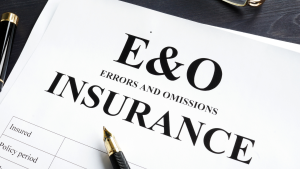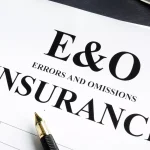Errors and Omissions Insurance Georgia
Comprehensive Guide
What is Errors and Omissions Insurance?
Errors and Omissions (E&O) insurance, also known as professional liability insurance, is a crucial coverage for businesses and professionals in Georgia. It protects against claims of negligence, mistakes, or failure to deliver services as promised. This type of insurance is especially important for professionals like consultants, real estate agents, lawyers, and financial advisors.
Why Do You Need Errors and Omissions Insurance in Georgia?
Operating a business in Georgia comes with various risks, and E&O insurance helps safeguard your financial stability by covering legal fees, settlements, and court costs in case of a lawsuit. Without this protection, your business could face significant financial losses.
Who Needs E&O Insurance?
If you provide professional services or advice, you should strongly consider E&O insurance. Some industries where this insurance is essential include:
- Real Estate Agents and Brokers
- Financial Advisors and Accountants
- Lawyers and Legal Consultants
- Insurance Agents
- Technology and IT Consultants
- Marketing and Advertising Agencies
How Does Errors and Omissions Insurance Work?
E&O insurance covers claims related to professional mistakes, negligence, or omissions. Here’s how it works:
- A claim is filed against your business.
- Your insurer investigates the claim.
- Legal fees, settlements, or judgments are covered up to the policy limits.
- Your business is protected from financial hardship due to lawsuits.
Key Coverages of E&O Insurance
- Legal defense costs
- Settlements and judgments
- Claims of negligence or misrepresentation
- Omissions in service delivery
- Breach of contract claims
Cost of Errors and Omissions Insurance in Georgia
The cost of E&O insurance varies based on several factors, including:
- Industry and risk level
- Business size and revenue
- Claims history
- Coverage limits and deductibles
On average, businesses in Georgia can expect to pay between $500 and $5,000 annually for an E&O policy, depending on their industry and risk exposure.
Choosing the Right E&O Insurance Policy
When selecting an Errors and Omissions insurance policy, consider the following:
- Coverage limits: Ensure your policy covers potential claim costs.
- Deductibles: Lower deductibles mean higher premiums but less out-of-pocket expense in case of a claim.
- Exclusions: Understand what your policy does not cover.
- Claims process: Choose an insurer with a straightforward claims process.
How to Get Errors and Omissions Insurance in Georgia
To obtain E&O insurance, follow these steps:
- Assess your risks: Identify potential legal vulnerabilities in your business.
- Compare policies: Get multiple quotes from insurance providers.
- Check insurer reputation: Choose a provider with strong financial stability and good customer reviews.
- Customize your policy: Ensure it meets your specific business needs.
- Review regularly: Update coverage as your business grows.

Frequently Asked Questions (FAQs)
What does Errors and Omissions Insurance not cover?
E&O insurance does not cover criminal acts, intentional wrongdoing, bodily injury, property damage, or false advertising claims.
Is E&O insurance required by law in Georgia?
While not legally required for all businesses, some industries, such as real estate and financial advising, may have mandatory E&O requirements.
How can I reduce the cost of my E&O insurance?
- Maintain a clean claims history
- Choose a higher deductible
- Bundle with other business insurance policies
- Implement risk management practices
Does E&O insurance cover independent contractors?
Yes, but they may need their own policies if not covered under the company’s policy.
How long does an E&O policy last?
Most policies operate on a claims-made basis, meaning they cover claims only while the policy is active.
Having Errors and Omissions Insurance in Georgia is a smart investment for any business offering professional services. By understanding its importance, cost, and coverage options, you can protect your business from unexpected legal claims and financial losses.
How much does E&O insurance cost?
The cost of Errors and Omissions (E&O) insurance in the U.S. varies depending on several factors, including the industry, company size, coverage limits, and claims history. On average:
-
Small businesses and independent contractors may pay $500 to $2,000 per year.
-
Mid-sized businesses and firms in high-risk industries (like finance and real estate) may pay between $2,500 and $5,000 annually.
-
Large corporations and highly regulated industries (such as legal or healthcare consulting) may see costs exceeding $10,000 per year.
Additional factors affecting cost include:
-
Coverage limits – Higher limits lead to higher premiums.
-
Deductibles – Higher deductibles can lower premiums.
-
Industry risk level – Professions with high legal exposure (financial advisors, lawyers, real estate agents) pay more.
-
Claims history – A history of lawsuits or claims can significantly increase rates.
Is errors and omissions insurance worth it?
Yes, E&O insurance is essential for professionals and businesses that provide services or advice. Without it, even a single lawsuit could lead to tens or even hundreds of thousands of dollars in legal fees, settlements, or judgments. Key reasons why E&O insurance is worth it include:
-
Legal Protection – Covers attorney fees, court costs, and settlements in case of client disputes.
-
Client Contracts – Many clients require businesses to carry E&O insurance before signing agreements.
-
Regulatory Compliance – Certain industries, like real estate, finance, and healthcare, may have legal E&O requirements.
-
Business Credibility – Having E&O coverage demonstrates professionalism and reliability to clients.
-
Peace of Mind – Ensures financial protection from unexpected legal claims.
Even if a lawsuit is unfounded, legal defense costs can be significant, making E&O insurance a smart investment for any service-based business.
What does errors and omissions insurance cover?
E&O insurance covers claims related to mistakes, negligence, and failure to deliver promised services. Some key areas covered include:
-
Legal defense costs – Attorney fees, court costs, and settlements.
-
Negligence – Failing to meet professional standards or making an error in service.
-
Misrepresentation – Providing false or misleading information to clients.
-
Breach of contract – Not fulfilling an agreement or missing deadlines.
-
Omissions – Leaving out crucial details that impact clients negatively.
-
Professional mistakes – Errors that cause financial losses for a client.
Most E&O policies operate on a claims-made basis, meaning they cover claims filed while the policy is active. Some insurers also offer tail coverage for claims made after policy expiration.

Which of the following is not covered by errors and omissions insurance?
While E&O insurance covers professional service-related claims, it does not cover:
-
Intentional wrongdoing or fraud – If a business knowingly deceives a client, coverage is void.
-
Bodily injury or property damage – These are covered under general liability insurance, not E&O insurance.
-
Employee disputes – Claims related to discrimination, harassment, or wrongful termination require employment practices liability insurance (EPLI).
-
Cybersecurity breaches – Data breaches or cyberattacks require cyber liability insurance.
-
False advertising – Claims related to deceptive advertising fall under media liability insurance.
Understanding what’s excluded is just as important as knowing what’s covered. Always review policy details before purchasing.
What is an example of errors and omissions insurance?
Here’s a real-world example of how E&O insurance can protect a business:
Example: A real estate agent in Atlanta, Georgia incorrectly informs a buyer that a property is in a commercial zone when, in fact, it is not. After purchasing the property, the buyer realizes they cannot use it for commercial purposes and sues the agent for financial damages.
-
Without E&O insurance, the real estate agent would have to pay for their own legal defense and any settlements.
-
With E&O insurance, the agent’s policy covers the legal fees, court costs, and potential settlement (up to the policy limits).
This coverage applies to many professions, including financial advisors, lawyers, consultants, IT professionals, and insurance agents.
Are all E&O policies claims made?
Yes, most Errors and Omissions policies are claims-made rather than occurrence-based. This means the policy only covers claims filed while the policy is active, regardless of when the incident occurred.
To maintain protection, businesses should:
-
Renew their E&O policy consistently to avoid gaps in coverage.
-
Consider tail coverage if they switch providers or retire, ensuring past incidents remain covered.
Some industries, like medical malpractice, may offer occurrence-based policies, which cover incidents that happened during the policy period, even if claims are filed after the policy expires.

How does E&O insurance work?
E&O insurance follows a step-by-step claims process:
-
A client files a claim – Alleging professional mistakes, negligence, or contract breaches.
-
Your insurance provider investigates – Reviews the claim, collects evidence, and determines liability.
-
Legal defense is arranged – The insurer provides lawyers, if necessary, to defend the business.
-
Settlements or judgments are paid – If the business is found liable, the insurer covers costs up to policy limits.
-
Business continues operations – With financial protection, the company avoids major losses.
This insurance protects against devastating financial losses that could arise from legal disputes.
What is the errors and omissions agreement?
An Errors and Omissions Agreement is a contractual clause that outlines the responsibilities of both service providers and clients regarding potential mistakes, omissions, and disputes. This agreement often includes:
-
Scope of services – Clearly defines what services are provided.
-
Liability limitations – Specifies how liability is handled in case of errors.
-
Dispute resolution terms – Details mediation or arbitration processes.
-
Insurance requirements – States whether E&O insurance is required and the coverage limits.
These agreements help businesses and clients avoid misunderstandings and legal disputes while ensuring accountability.









